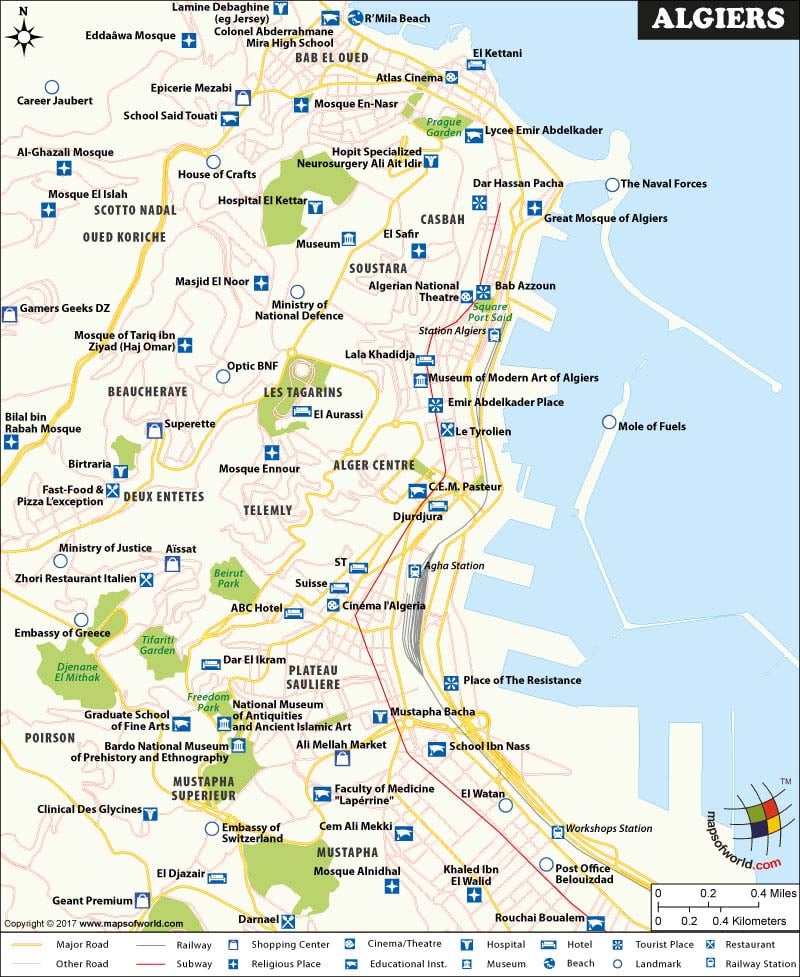Algiers is the capital, commercial hub, and cultural center of Algeria. Besides, it is also noted for being the largest city of Algeria. It covers an area of 363 sq km and had an approximate population of 3,415,811 in 2011. The city was originally a harbor, much used by the pirates and even today, it is the most important part of the country.
About the City
Algiers was originally founded by the Phoenicians as a part of their North African colonies. It was then named Iconium. In the 16th century, it became a refuge for the Moors expelled from Spain. In 1529, the town was seized by Barbarossa – a Turkish corsair, who placed the town under the authority of the Ottoman Empire. Under his regime, Algiers turned into a favorite base for the Barbary pirates for the next 300 years. The Europeans tried to quell the piracy and finally, it was captured by the French in 1830. Algiers remained the capital of the French colonial empire in Africa. Finally, in 1962, Algeria became independent and Algiers became its capital.
Geography
Algiers is situated on a bay of the Mediterranean Sea on the coast of North Africa. The town rises from a number of small islands, which have now merged together to the steep slopes of the Sahel Mountains. The city faces east and north, and glistening white buildings form an amphitheater. This is why the French called the city, Alger La Blanche (Algiers, the White).
The city enjoys a Mediterranean type of climate. Summers are warm and dry while winters are mild and wet. Most of the rainfall occurs between October and April. The moderating influence of the breeze from the Mediterranean Sea helps Algiers to avoid the extremes of temperature that are common in the nearby deserts.
How to reach (transport)
You can travel to Algiers by the following means:
- You can fly to the Houari Boumediene Airport, which is located about 20 km to the southeast of the city. Flights connect the city to a number of cities in Africa and Asia and a few in Europe.
- You can reach Algiers from any other place in Algeria by train. The rail network has been updated in the country and it has become an important means of transport.
- Algiers is a port. You can also reach the city by water. Regular ferry services exist between Algiers and Marseilles, Nice, Palermo, and Alicante.
When to visit
The best time to visit Algiers is during winter because the climate is most pleasant. However, nights can be quite cold for which heavy clothing is essential.
Culture (Fairs and Festivals) and Traditions
While the old parts of Algiers bear the mark of its long and eventful history, the modern quarters around the harbor are completely different. The city is very active and bustling. Some of the festivals which are celebrated in or near the city are as follows:
- The National Amazigh Film Festival is held in January. Full-length feature films, short documentaries, and animations are showcased here celebrating the Amazigh culture in Algeria.
- The European cultural festival is celebrated in early May and is one of the most beautiful festivals in the country. Artists from about 16 countries gather here to perform flamenco, jazz, and traditional rhythms.
- The Pan African cultural festival is a huge event celebrated in various venues throughout Algeria. More than 8,000 performers gather to promote their arts. Musicians, actors, and authors are the most common participants.
- Independence Day is celebrated on July 5. On this day, the country won its freedom from French rule. The day is marked by several cultural events.
Points of interest (places to visit)
Some of the most interesting sights of Algiers are as follows:
- The Musée National du Moudjahid is an important museum in Algiers which collects and displays exhibits related to the colonial rule and the struggle for independence of the country.
- Casbah is the ancient city within Algiers and it has been named a World Heritage site by UNESCO. Dating back to the 17th century, it contains some of the oldest mosques of Algiers like El Kebir, El Djedid, etc.
- Dar Hassan Pacha is one of the oldest and grandest mansions in the city.
- Jardin d’Essai is one of the world’s largest natural hothouses. The project was started by the French to test which crops would grow best here. It has been developed after independence and is one of the most beautiful parks of the city.
- The Museum of Popular Arts and Traditions is located in a beautiful Ottoman-era palace in one of the more accessible parts of Casbah and contains a very edifying collection of Algerian arts and crafts.
- The Makam Echahid is one of the most well-known monuments of the city. It celebrates the sacrifices of an unknown martyr. Three massive concrete palm fronds signifying agriculture, industry, and culture, represent the three pillars that make Algeria great.
Accommodation
Those eyeing a comfortable trip can find quite a few good places to stay in Algiers. For a luxurious stay, you can count on 5-star options like El Aurassi and Sofitel Algiers Hamma Garden. Those traveling on a lesser budget can go for 3-star options like Samir, Dar el Ikram, and Dar Diaf Alger.
